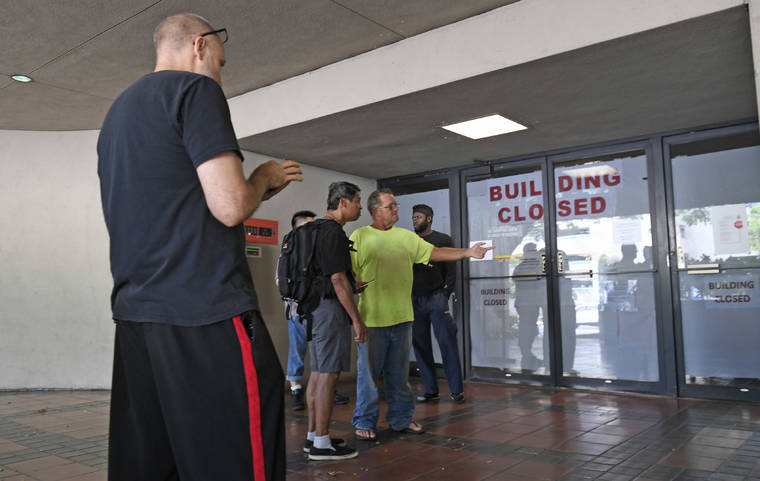Hawaii unemployment fund will run out, but safety net awaits

BRUCE ASATO / BASATO@STARADVERTISER.COM
A group of people showed up at the state Unemployment Office on Monday after it closed its doors to the public. The office is accepting applications only online.
The floodgates haven’t opened wide yet, but the pool of state unemployment insurance money is about to start draining at an incredibly fast rate Opens in a new tab — so fast that the roughly $600 million fund could be dry several months from now.
Despite the dire sound of such a loss, the growing legion of jobless Hawaii residents shouldn’t worry about money being available to pay them unemployment benefits for up to six months.
“We’re going to be able to pay benefits one way or another,” said Bill Kunstman, spokesman for the state Department of Labor and Industrial Relations.
That assurance is possible because the state can borrow from the federal government to cover benefit payments until the normal mechanism for building up the fund — employer payroll taxes — recovers along with the broader economy as the government lifts restrictions on business activity put in place to combat the spread of the coronavirus pandemic.
“There’s a safety net for the safety net,” said DLIR Director Scott Murakami.
Murakami said there’s no reliable estimate how fast the fund likely will be depleted because not everyone filing for unemployment qualifies for the $648 maximum weekly benefit, and they might need the benefit for fewer than the maximum 26 weeks.
Don't miss out on what's happening!
Stay in touch with breaking news, as it happens, conveniently in your email inbox. It's FREE!
If everyone who filed for unemployment so far this month got the maximum payment, the fund would be down to nothing in 11 weeks.
“The $594 million that we had in the fund at the start of March will be depleted quickly,” he said.
The goal to start paying claimants following an application filing is two weeks, though DLIR said most of the time recently it has been about three weeks and that the lag likely will be longer now given the overwhelming number of claims needing processing.
Another factor that makes the draw-down rate of the fund challenging to estimate is how many more people will file for unemployment in the coming days, weeks or perhaps months.
New unemployment claims this week hit 19,534 Monday, 20,041 Tuesday and 15,801 Wednesday. For all of March through Wednesday, the total is 82,963. That compares with about 18,000 unemployed people for all of last year.
DLIR said in a December report that its fund, which stood at $607.5 million in November, would be enough to finance about one year of unemployment at the worst level experienced during the last decade.
That worst experience was in 2010 in the wake of the Great Recession, when about 45,000 people in Hawaii were unemployed.
The unemployment fund in 2010 dropped to minus $11.6 million after three consecutive years of declines from $552.2 million in 2007.
After paying off a $14.6 million federal loan in 2010, DLIR’s unemployment fund grew again for nine years.
Only one other time between 1970 and 2010 did the fund go negative. That was 1976, following a couple of years of mainland recessionary impacts on Hawaii’s economy that led DLIR to borrow $22.5 million from the federal government to cover unemployment fund shortfalls.
It’s certain that the two prior loans will dwarf the one needed this year, but to what extent is anyone’s guess.
The fund eventually should be built back up from payroll taxes that employers pay. Under state rules, businesses that produce more unemployment get charged higher tax rates. Also, tax rates in the past have been increased to rebuild low fund balances.
Such an increase could take a year or so to take effect, according to Kunstman.
Last year DLIR collected $178 million in assessments, earned $14 million on interest from its fund balance and paid out $151 million in benefits.
Other changes also could be possible. When the fund was exhausted in 1976, state lawmakers held hearings on how to address the issue and proposed changes to who qualifies for unemployment and increased assessments on employers.
The federal government also could possibly help replenish state unemployment funds. Congress is poised to pass legislation today that would add $600 to the weekly benefit payment for four months, but that wouldn’t affect withdrawals from the state fund.
John Morgan, president and CEO of Kualoa Ranch, said he’s glad federal and state officials are helping employees who have no work because of the clampdown on social interactions to inhibit the spread of COVID-19.
Kualoa Ranch ceased operations March 16, and the company committed to pay employees for two weeks through Sunday. On Wednesday, Morgan informed employees that furloughs, which suspend pay and work, temporarily allowing for unemployment benefits, would be necessary for about 250 of the company’s 350 employees.
“Hunkering down is one thing, and I think our whole community is doing an amazing job of accepting and dealing with this situation, but not knowing when people will be able to get back to their normal routines and get a full paycheck can be very disconcerting,” Morgan said.



